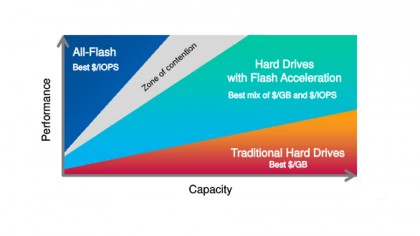Is there a perfect balance of performance and capacity for business storage?
HDD, flash or hybrid?
Flash technology is not a one-size-fits-all solution as there remains a significant, but closing, cost delta between flash and traditional hard disk-based systems. This is why it is imperative that businesses understand their business application workloads before deciding on the best storage implementation. The best solution is the one that balances performance and capacity.
For those specific workloads that need extreme speed, then all-flash-arrays can be the solution. This would offer the best cost per IOPS of all the solutions available. For the workloads that need the burst of extreme performance but require a level of cost efficiency in terms of £ per Gigabyte, we would suggest taking a hybrid flash/HDD approach. The graph below shows the trade-off:

The key difference between the all-flash and hybrid approach is the latency levels. A hybrid will utilise flash to give a good average of latency, whereas an all-flash array will give a consistent, predictable low level of latency. It doesn't mean that one is a better approach than the other, depending on whether workload latency will or will not be an issue – and we are only talking milliseconds in difference. For many a hybrid approach has become the new norm when it comes to managing most common workloads.
As discussed previously, more and more businesses are starting to consider all-flash arrays as viable storage solutions for their business applications. A lot of this has to do with the reduction in the cost of flash, and with intelligent management and a higher level of predictability, endurance of flash drives is no longer an issue.
MLC and TLC
This has led to a next step in flash, the introduction of Multi-Level Cells (MLC) and Triple-Level Cells (TLC), which are basic multiplications of Standard-Level Cells (SLC) that increase the 0s and 1s that can be stored, with two for SLC, four for MLC and eight for TLC. This drastically improves performance but does somewhat impact endurance and reliability, meaning that the industry still has some work to do to make sure that TLC in particular is enterprise-class.
That said, in a few years' time the industry is going to be at a very interesting impasse as it is predicted that in 2017 the cost of TLC will drop below SAS HDDs for the first time. SAS HDDs are the performance drive in comparison to the SATA HDD, which is built for capacity. This pricing crossroads will mean that enterprises will have a decision to make on whether full-flash arrays are going to be the best option to manage the increasing level of real-time data that needs to be accessed.
Storage evolution
No-one can be totally sure what the business workloads of the future will be, but if we look back three to five years ago, business data analysis applications didn't exist – and now they are seen as a key driver in creating business value through data. As these workloads have evolved, next-generation applications have been designed with flash in mind – not drives that use spinning disks. It has become the natural evolution of storage, from tape, to disc, to flash cells.
Are you a pro? Subscribe to our newsletter
Sign up to the TechRadar Pro newsletter to get all the top news, opinion, features and guidance your business needs to succeed!
One thing can be guaranteed: the storage industry will continue to innovate to meet the changing demands of customers. But for the businesses looking to take advantage of these innovations they first need to understand the applications that are imperative to keeping them competitive through intelligent capacity and performance planning. Those businesses that don't do this face playing a game of catch up, but as the speed of innovation increases, any hesitation may see their competitors streak ahead – as quick as a flash.
- Laurence James is NEMEA Products, Alliances and Solutions Marketing Manager at NetApp